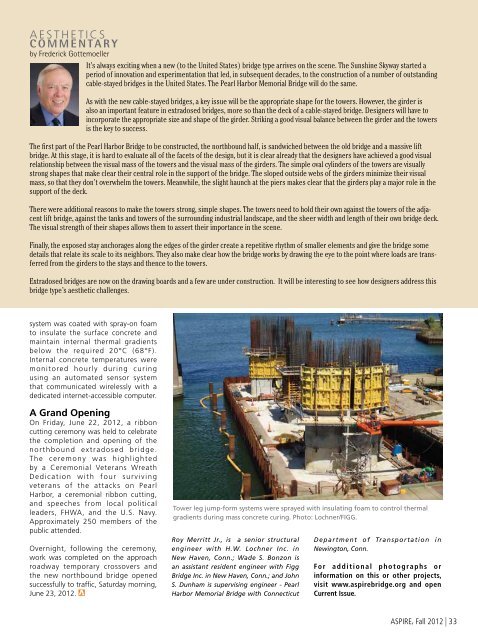Pearl Harbor Memorial Bridge - Aspire - The Concrete Bridge ...
Pearl Harbor Memorial Bridge - Aspire - The Concrete Bridge ...
Pearl Harbor Memorial Bridge - Aspire - The Concrete Bridge ...
You also want an ePaper? Increase the reach of your titles
YUMPU automatically turns print PDFs into web optimized ePapers that Google loves.
AESTHETICSCOMMENTARYby Frederick GottemoellerIt’s always exciting when a new (to the United States) bridge type arrives on the scene. <strong>The</strong> Sunshine Skyway started aperiod of innovation and experimentation that led, in subsequent decades, to the construction of a number of outstandingcable-stayed bridges in the United States. <strong>The</strong> <strong>Pearl</strong> <strong>Harbor</strong> <strong>Memorial</strong> <strong>Bridge</strong> will do the same.As with the new cable-stayed bridges, a key issue will be the appropriate shape for the towers. However, the girder isalso an important feature in extradosed bridges, more so than the deck of a cable-stayed bridge. Designers will have toincorporate the appropriate size and shape of the girder. Striking a good visual balance between the girder and the towersis the key to success.<strong>The</strong> first part of the <strong>Pearl</strong> <strong>Harbor</strong> <strong>Bridge</strong> to be constructed, the northbound half, is sandwiched between the old bridge and a massive liftbridge. At this stage, it is hard to evaluate all of the facets of the design, but it is clear already that the designers have achieved a good visualrelationship between the visual mass of the towers and the visual mass of the girders. <strong>The</strong> simple oval cylinders of the towers are visuallystrong shapes that make clear their central role in the support of the bridge. <strong>The</strong> sloped outside webs of the girders minimize their visualmass, so that they don’t overwhelm the towers. Meanwhile, the slight haunch at the piers makes clear that the girders play a major role in thesupport of the deck.<strong>The</strong>re were additional reasons to make the towers strong, simple shapes. <strong>The</strong> towers need to hold their own against the towers of the adjacentlift bridge, against the tanks and towers of the surrounding industrial landscape, and the sheer width and length of their own bridge deck.<strong>The</strong> visual strength of their shapes allows them to assert their importance in the scene.Finally, the exposed stay anchorages along the edges of the girder create a repetitive rhythm of smaller elements and give the bridge somedetails that relate its scale to its neighbors. <strong>The</strong>y also make clear how the bridge works by drawing the eye to the point where loads are transferredfrom the girders to the stays and thence to the towers.Extradosed bridges are now on the drawing boards and a few are under construction. It will be interesting to see how designers address thisbridge type’s aesthetic challenges.system was coated with spray-on foamto insulate the surface concrete andmaintain internal thermal gradientsbelow the required 20°C (68°F).Internal concrete temperatures weremonitored hourly during curingusing an automated sensor systemthat communicated wirelessly with adedicated internet-accessible computer.A Grand OpeningOn Friday, June 22, 2012, a ribboncutting ceremony was held to celebratethe completion and opening of thenorthbound extradosed bridge.<strong>The</strong> ceremony was highlightedby a Ceremonial Veterans WreathDedication with four survivingveterans of the attacks on <strong>Pearl</strong><strong>Harbor</strong>, a ceremonial ribbon cutting,and speeches from local politicalleaders, FHWA, and the U.S. Navy.Approximately 250 members of thepublic attended.Overnight, following the ceremony,work was completed on the approachroadway temporary crossovers andthe new northbound bridge openedsuccessfully to traffic, Saturday morning,June 23, 2012.Tower leg jump-form systems were sprayed with insulating foam to control thermalgradients during mass concrete curing. Photo: Lochner/FIGG.Roy Merritt Jr., is a senior structuralengineer with H.W. Lochner Inc. inNew Haven, Conn.; Wade S. Bonzon isan assistant resident engineer with Figg<strong>Bridge</strong> Inc. in New Haven, Conn.; and JohnS. Dunham is supervising engineer - <strong>Pearl</strong><strong>Harbor</strong> <strong>Memorial</strong> <strong>Bridge</strong> with ConnecticutDepartment of Transportation inNewington, Conn.For additional photographs orinformation on this or other projects,visit www.aspirebridge.org and openCurrent Issue.ASPIRE, Fall 2012 | 33
















